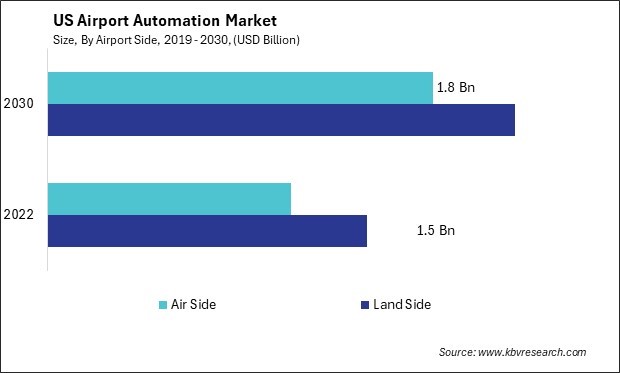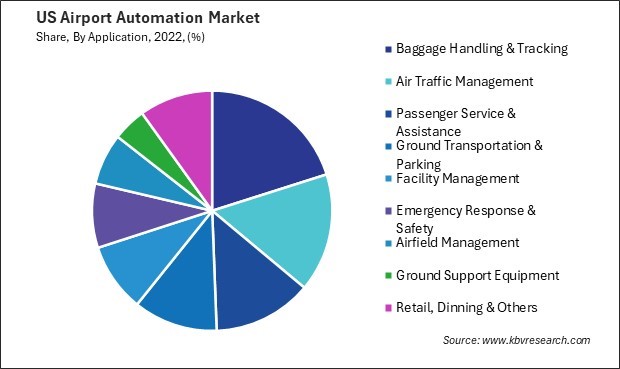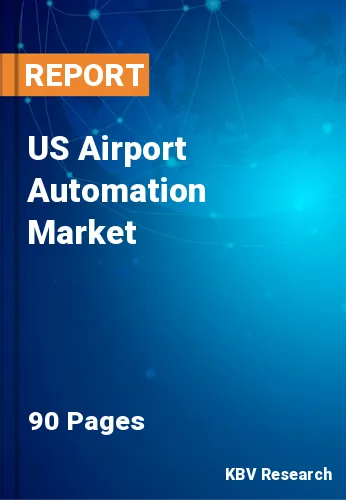The United States (US) Airport Automation Market size is expected to reach $3.9 Billion by 2030, rising at a market growth of 4.9% CAGR during the forecast period.
The airport automation market in the United States has witnessed significant growth in recent years, driven by technological advancements, increasing air passenger traffic, and the need for efficient airport operations. One of the key drivers of automation adoption in airports is the need to enhance operational efficiency and passenger experience. Automated check-in and bag drop systems, for example, streamline the passenger journey, reducing waiting times and enhancing overall satisfaction.

Furthermore, adopting automation in airports is also driven by regulatory requirements and industry standards to enhance security and safety measures. For example, the Transportation Security Administration (TSA) in the United States has implemented various initiatives to improve airport security, including deploying advanced screening technologies and expanding trusted traveler programs. Automation is crucial in supporting these efforts by enabling faster and more efficient security checks and enhancing airport security.
Additionally, the adoption of automation in U.S. airports is driven by the need to cope with the growing demand for air travel. With passenger numbers expected to continue rising, airports are under pressure to expand capacity and improve throughput without compromising safety or quality of service. Automation offers a scalable solution to these challenges by optimizing existing infrastructure and processes.
Moreover, the COVID-19 pandemic has accelerated the adoption of airport automation to minimize physical contact and reduce the risk of virus transmission. Contactless technologies, such as facial recognition for identity verification and touchless kiosks for check-in, have become increasingly popular to support social distancing measures and enhance hygiene standards. Additionally, autonomous cleaning robots equipped with disinfection capabilities have been deployed in many airports to ensure thorough sanitation of high-touch surfaces.
In recent years, the airport automation market in the United States has witnessed a significant surge in the development of greenfield projects. These projects represent new airport constructions or expansions designed to incorporate advanced automation technologies from the ground up. One key driver behind the rise of greenfield projects in the airport automation market is the increasing demand for streamlined operations and enhanced security measures. With air travel becoming more prevalent, airports are under pressure to handle larger volumes of passengers and aircraft while maintaining high levels of safety and security.
Moreover, greenfield projects enable airport authorities to adopt sustainable practices and reduce their environmental footprint. By incorporating energy-efficient technologies, such as smart lighting, heating, ventilation, air conditioning (HVAC) systems, and renewable energy sources like solar panels, airports minimize their carbon emissions and energy consumption. The surge in greenfield investment expenditures reflects a significant trend toward establishing new businesses or expanding existing ones in the United States. These investments encompass projects such as the automation of airports, indicating a growing emphasis on modernization and efficiency.
According to the U.S. Department of Commerce, in 2021, there was a notable surge in greenfield investment expenditures, totaling $3.4 billion. These investments encompassed establishing new businesses within the U.S. or expanding existing businesses owned by foreign entities. Moreover, for greenfield projects initiated in 2021, the cumulative planned expenditures until completion, comprising both initial year and subsequent expenditures, amounted to $15.6 billion. This trend reflects a significant increase in greenfield projects in airport automation across the United States.
Furthermore, greenfield projects often involve integrating innovative digital technologies, such as artificial intelligence (AI), Internet of Things (IoT), and data analytics, to optimize airport operations and enhance the passenger experience. Thus, the surge in greenfield projects in the United States airport automation market underscores a concerted effort toward efficiency, sustainability, and passenger-centric innovation.
The airport automation market in the United States is witnessing a substantial increase in demand driven by several factors. One of the primary drivers of this demand is the growing air traffic volume across the U.S. Airports are experiencing increasing pressure to handle larger numbers of flights and passengers efficiently. Automation technologies such as automated baggage handling systems, self-service kiosks for check-in and boarding, and automated security screening processes help airports streamline operations, reduce congestion, and improve overall passenger throughput.
Moreover, emphasizing safety and security further fuels the demand for airport automation and control systems. Advanced technologies such as biometric authentication, facial recognition, and AI-powered video analytics are being deployed to enhance security measures while ensuring a smooth flow of American passengers through various checkpoints.
Efficiency gains are another significant driver of automation adoption in airports. Automated systems in the U.S. enable airports to optimize resource utilization, minimize delays, and reduce operational costs. For instance, automated air traffic control systems help manage airspace more efficiently, reducing delays and improving flight punctuality. Similarly, automated ground handling equipment and maintenance systems contribute to quicker turnaround times for aircraft, enhancing operational efficiency for airlines and airports. Hence, the surge in demand for airport automation in the United States is fueled by the need to efficiently handle increasing air traffic, enhance safety measures, and achieve greater operational efficiency.

The airport automation market in the United States is a dynamic sector characterized by technological advancements to enhance operational efficiency, passenger experience, and airport safety. One prominent player in the U.S. airport automation market is SITA. As a global air transport communications and IT solutions leader, SITA provides cutting-edge technology to automate airport operations. The company offers a comprehensive suite of solutions, including passenger processing systems, baggage management systems, and airport operational databases. SITA's expertise lies in harnessing data analytics and artificial intelligence to optimize airport processes, improve resource allocation, and enhance the overall passenger journey.
Another major player in the airport automation market is Rockwell Collins, now part of Collins Aerospace, a subsidiary of Raytheon Technologies Corporation. Collins Aerospace is a leading provider of advanced avionics, communication, and automation solutions for the aerospace industry. The company offers various products and services within the airport automation sector, including self-service kiosks, biometric authentication systems, and integrated airport management platforms. Collins Aerospace's innovative technologies aim to streamline passenger flows, reduce wait times, and enhance security measures across airport terminals.
Furthermore, Honeywell International Inc. is a key player in the U.S. airport automation market, offering a diverse portfolio of products and services tailored to the aviation industry. Honeywell's offerings include airport security systems, surveillance technologies, and integrated control systems for air traffic management. The company's commitment to innovation drives the development of advanced automation solutions to enhance safety, reliability, and operational performance across airport environments.
In addition to these major players, several other companies contribute to the airport automation market in the United States. For instance, BEUMER Group GmbH & Co. KG provides automated baggage handling systems and logistics solutions to optimize baggage flows and enhance airport throughput. Vanderlande Industries, a subsidiary of Toyota Industries Corporation, specializes in automated material handling systems, including baggage handling solutions and automated passenger boarding bridges. With the continued emphasis on enhancing passenger experience, optimizing operational efficiency, and ensuring safety and security, the demand for advanced automation technologies in the aviation industry is expected to remain robust, driving further growth and innovation in the airport automation market.
By Airport Side
By Automation Level
By System
By End Market
By Application
Our team of dedicated experts can provide you with attractive expansion opportunities for your business.

